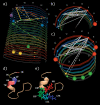MAVL/StickWRLD: analyzing structural constraints using interpositional dependencies in biomolecular sequence alignments
- PMID: 16844976
- PMCID: PMC1538782
- DOI: 10.1093/nar/gkl251
MAVL/StickWRLD: analyzing structural constraints using interpositional dependencies in biomolecular sequence alignments
Abstract
The increasing availability of structurally aligned protein families has made it possible to use statistical methods to discover regions of interpositional dependencies of residue identity. Such dependencies amongst residues often have structural or functional implications, and their discovery can supply valuable constraints that assist in the refinement of measured, or predicted molecular structure assignments. Multiple Alignment Variation Linker (MAVL) and StickWRLD [W. Ray (2004) Nucleic Acids Res., 32, W59-W63] were developed to analyze and visualize nucleic acid and protein alignments, to discover and illuminate position/location relationships to the user. The original system analyzed users' data from a web-form submission and presented the user with a static VRML diagram describing their data. We are pleased to report that MAVL/StickWRLD has been completely redesigned and rewritten. MAVL/StickWRLD now functions as a platform-independent Java applet, with real-time dynamic controls that enable much more intuitive exploration and interaction with the data. The system has also been upgraded to enable visualization of a range of aggregate residue properties, and an extensive database of pre-computed StickWRLD diagrams based on PFAM families is now available directly from the interface. The Java StickWRLD applet is available via the WWW at http://www.microbial-pathogenesis.org/stickwrld/.
Figures

Similar articles
-
MAVL/StickWRLD for protein: visualizing protein sequence families to detect non-consensus features.Nucleic Acids Res. 2005 Jul 1;33(Web Server issue):W315-9. doi: 10.1093/nar/gki374. Nucleic Acids Res. 2005. PMID: 15980480 Free PMC article.
-
MAVL and StickWRLD: visually exploring relationships in nucleic acid sequence alignments.Nucleic Acids Res. 2004 Jul 1;32(Web Server issue):W59-63. doi: 10.1093/nar/gkh469. Nucleic Acids Res. 2004. PMID: 15215351 Free PMC article.
-
VISSA: a program to visualize structural features from structure sequence alignment.Bioinformatics. 2006 Apr 1;22(7):887-8. doi: 10.1093/bioinformatics/btl019. Epub 2006 Jan 24. Bioinformatics. 2006. PMID: 16434438
-
Expresso: automatic incorporation of structural information in multiple sequence alignments using 3D-Coffee.Nucleic Acids Res. 2006 Jul 1;34(Web Server issue):W604-8. doi: 10.1093/nar/gkl092. Nucleic Acids Res. 2006. PMID: 16845081 Free PMC article.
-
ProKware: integrated software for presenting protein structural properties in protein tertiary structures.Nucleic Acids Res. 2006 Jul 1;34(Web Server issue):W89-94. doi: 10.1093/nar/gkl235. Nucleic Acids Res. 2006. PMID: 16845116 Free PMC article.
Cited by
-
The Importance of Weakly Co-Evolving Residue Networks in Proteins is Revealed by Visual Analytics.Front Bioinform. 2022 Apr 5;2:836526. doi: 10.3389/fbinf.2022.836526. eCollection 2022. Front Bioinform. 2022. PMID: 36304294 Free PMC article.
-
Protein stability: computation, sequence statistics, and new experimental methods.Curr Opin Struct Biol. 2015 Aug;33:161-8. doi: 10.1016/j.sbi.2015.09.002. Curr Opin Struct Biol. 2015. PMID: 26497286 Free PMC article. Review.
-
Consensus protein design.Protein Eng Des Sel. 2016 Jul;29(7):245-51. doi: 10.1093/protein/gzw015. Epub 2016 Jun 5. Protein Eng Des Sel. 2016. PMID: 27274091 Free PMC article. Review.
-
Understanding the sequence requirements of protein families: insights from the BioVis 2013 contests.BMC Proc. 2014 Aug 28;8(Suppl 2 Proceedings of the 3rd Annual Symposium on Biologica):S1. doi: 10.1186/1753-6561-8-S2-S1. eCollection 2014. BMC Proc. 2014. PMID: 25237388 Free PMC article.
-
Optimization of Synthetic Proteins: Identification of Interpositional Dependencies Indicating Structurally and/or Functionally Linked Residues.J Vis Exp. 2015 Jul 14;(101):e52878. doi: 10.3791/52878. J Vis Exp. 2015. PMID: 26274377 Free PMC article.
References
-
- Vinogradova O., Velyvis A., Velyviene A., Hu B., Haas T.A., Plow E.F., Qin J. A structural mechanism of integrin alfaIIb beta3 ‘inside-out’ activation as regulated by its cytoplasmic face. Cell. 2002;110:587–597. - PubMed
-
- Humphries M.J., McEwan P.A., Barton S.J., Buckley P.A., Bella J., Mould A.P. Integrin Structure: heady advances in ligand binding, but activation still makes the knees wobble. Trends Biochem. Sci. 2003;28:313–319. - PubMed
Publication types
MeSH terms
LinkOut - more resources
Full Text Sources

